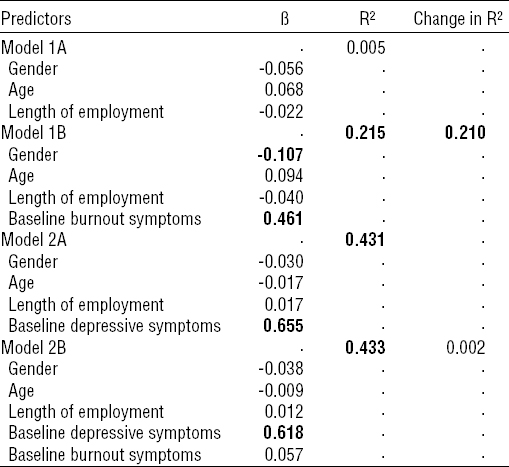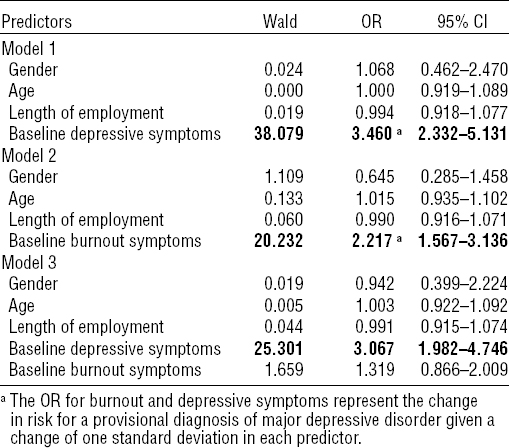Burnout has been defined as a chronic occupational stress syndrome combining two main dimensions, emotional exhaustion (loss of energy and feeling of helplessness) and depersonalization (loss of motivation and withdrawal from work) (1, 2). Depression is primarily characterized by anhedonia and depressed mood (3). Unresolvable stress plays a key role in the etiology of depression (4, 5). In an attempt to understand the relationship between burnout and depression, it has been hypothesized that burnout is a phase in the development of depression (6–10). However, there is a paucity of research testing this hypothesis.
In a previous study, we examined the extent to which changes in burnout and depression covaried, capitalizing on two waves of data collected on a sample of French school teachers (11). In this study, we used the same data set to evaluate the hypothesis that burnout at baseline predicts depression at follow-up independently of depression at baseline. Thereby, our aim was to help clarify the burnout–depression relationship.
Methods
Study participants and data collection
A convenience sample of 627 French school teachers [mean age at time 1 (T1): 41 years old; 73% female] took part in the two waves of a survey that assessed burnout and depression. Teachers are considered to be at particularly high risk for chronic job stress and burnout (12). The participants were recruited via school administrators throughout France. School administrators were requested to transmit the proposed survey to their schools’ teachers to permit them to complete it should they so choose (for further details, see (11)]. We note that our recruitment procedure did not allow us to estimate the response rate. Indeed, the number of teachers who actually received the survey from their school administrators is unknown. The mean duration separating the T1 from the time 2 (T2) data collection wave was 21 months. The study was conducted in accordance with ethical guidelines of the Declaration of Helsinki.
Variables of interest
Burnout was assessed with the emotional exhaustion (9 items) and depersonalization (5 items) subscales of the Maslach Burnout Inventory (MBI), the most widely used instrument for assessing burnout (12). The MBI includes a third subscale that assesses personal accomplishment. Personal accomplishment, however, was not present in the original working definition of burnout, and its correlation to the burnout syndrome is questionable (1, 2, 8). Emotional exhaustion and depersonalization mean scores were averaged in order to obtain a global burnout index for each participant (8, 11). The computation of a global burnout index is recommended when examining burnout as a unified entity (13). MBI scoring is based on a 7-point frequency rating scale ranging from 0 (“never”) to 6 (“everyday”). The combined emotional exhaustion and depersonalization subscales showed strong internal consistency in this study (αT1=0.88; αT2=0.89).
Depression was assessed with the 9-item depression module (αT1=0.82; αT2=0.83) of the Patient Health Questionnaire (PHQ-9) (14). The PHQ-9 allows the investigator to (i) grade the severity of depressive symptoms (from 0–27) and (ii) establish provisional diagnosis of major depression in accordance with the Diagnostic and Statistical Manual of Mental Disorders based on a dedicated algorithm (3, 14). Because of this double function, the PHQ-9 is a particularly useful tool in depression research.
A sociodemographic questionnaire was additionally administered. Participants were asked to report their gender, age, and length of employment.
Data analyses
Depression was treated both as a continuous and a categorical variable using linear and logistic regression analyses. Baseline burnout and depressive symptoms were used as predictors, controlling for gender, age, and length of employment. Depressive symptoms at T2 constituted the predicted variable in linear regression analysis whereas provisionally diagnosed cases of major depression at T2 constituted the predicted variable in logistic regression analysis.
Results
At T1, of the 627 participants, 271 (43%), 307 (49%), and 49 (8%) had mean burnout scores of 0.00–1.99, 2.00–3.99, and 4.00–6.00, respectively, suggesting that burnout symptom levels and health conditions were diverse in the study sample.
The correlation between burnout and depression was 0.64 at T1 and 0.68 at T2. Results from linear regression analysis are summarized in table 1. When depressive symptoms at T1 were controlled for, burnout symptoms at T1 no longer predicted depressive symptoms at T2. Depressive symptoms at T1 accounted for about 88% of the association between burnout symptoms at T1 and depressive symptoms at T2, with a β value falling from 0.461 to 0.057. When considering gender, age, length of employment, baseline depressive symptoms, and baseline burnout symptoms in a single model, only baseline depressive symptoms significantly predicted depressive symptoms at follow-up.
Table 1
Summary of linear regression analysis (N=627) predicting depressive symptoms at follow-up. Bolded values are significant at P≤0.010 or lower. Nonbolded values are nonsignificant (P>0.050).

Results from logistic regression analysis are summarized in table 2. Among the 627 teachers enrolled at T1, 85 (about 14%) received a provisional diagnosis of major depression at T1 and were excluded from this analysis. Among the 542 remaining participants, 37 (about 7%) met criteria for a provisional diagnosis of major depression at T2. Burnout symptoms at T1 no longer predicted cases of major depression at T2 when depressive symptoms at T1 were included in the predictive model. When considering gender, age, length of employment, baseline depressive symptoms, and baseline burnout symptoms in a single model, only baseline depressive symptoms significantly predicted incident cases of major depression at follow-up.
Discussion
We sought to determine whether burnout is a predictor of depression, relying on a 2-wave, 21-month follow-up and a sample of 627 French school teachers. Indeed, there is a paucity of research on this issue. It turned out that burnout at T1 did not predict depression at T2 independently of depression at T1. This pattern of results was observed regarding the prediction of both depressive symptoms and provisionally diagnosed cases of major depression. Thus, our dimensional and categorical analyses consistently indicated that assessing burnout symptoms in addition to “classical” depressive symptoms may not strengthen our ability to predict depression among French school teachers.
This study does not replicate past findings suggesting that burnout predicts depression (6–8, 10). For instance, in a 3-wave, 7-year study of Finnish dentists, Hakanen & Schaufeli (8) found that burnout symptoms predicted depressive symptoms from T1 to T2 (N=2555) as well as from T2 to time 3 (T3; N=1964). Shin et al (10) reported a similar relationship between burnout and depressive symptoms from T1 to T2 and from T2 to T3 in a study of 499 South Korean teachers. Baseline depressive symptoms were controlled for in each of these two studies. A problematic aspect of Shin et al’s study (10), however, is that the response alternatives for the T2 and T3 burnout items overlapped the period covered by burnout items assessed during the previous wave of data collection; by contrast, their depression items, with a one-week look-back, did not. All in all, differences in statistical approaches, theoretical options, follow-up duration, the number of waves of measurement, and countries/cultures of interest may account for these apparently divergent results. Further research is needed to clarify how these factors affect study outcomes.
Our findings are in line with recent research adopting a person-centered approach to burnout and depression (11, 15). Relying on the same study sample as Hakanen & Schaufeli (8), Ahola et al (15) found that burnout and depressive symptoms clustered and developed in parallel at similar levels over a 7-year period of time. The intertwining of burnout and depressive symptoms manifested itself in the four developmental trajectories – low, high, increasing, and decreasing symptoms – that emerged in the authors’ longitudinal analysis. These results suggest that differences in statistical approaches and theoretical options may indeed be critical in explaining the heterogeneity of the reported findings.
Our study has at least five limitations. First, the PHQ-9 allowed us to establish provisional diagnoses of major depression for the purpose of our categorical analyses. A standard diagnosis of major depression, however, requires the use of clinician-conducted structured psychiatric interviews (3, 16). Second, the representativeness of the study sample is unknown. Third, the participants were not asked at T2 if they were still working teachers or were on sick leave or had quit the profession. Fourth, only one occupational group (school teachers) was considered. This being said, we note that this restriction to one occupation has the advantage of promoting homogeneity within the study sample. Fifth, although we tested the dominant conceptualization of burnout by using the MBI, alternative conceptualizations of the syndrome have been developed (17) and remain to be examined.
The present findings question the idea that burnout paves the way to depression. Thereby, this study invites reconsideration of the way the burnout–depression link has been envisaged in past research. By suggesting between-syndrome overlap (about 88% of the association between burnout symptoms at T1 and depressive symptoms at T2 were accounted for by depressive symptoms at T1), our findings are consistent with the view that core burnout symptoms are depressive in nature (11). Whether burnout and depressive symptoms are distinct or overlapping features should be further elucidated.




